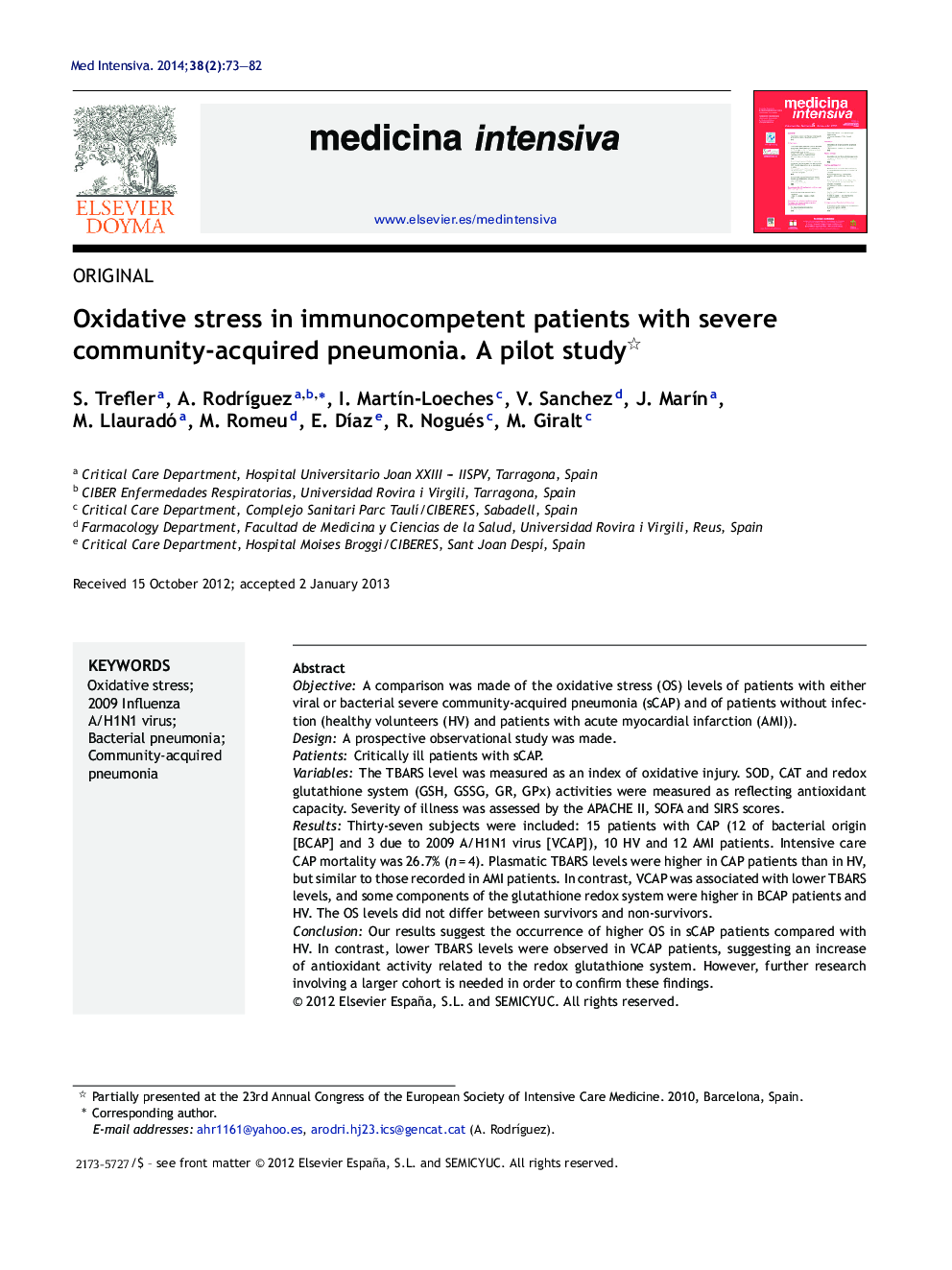| Article ID | Journal | Published Year | Pages | File Type |
|---|---|---|---|---|
| 3114154 | Medicina Intensiva (English Edition) | 2014 | 10 Pages |
ObjectiveA comparison was made of the oxidative stress (OS) levels of patients with either viral or bacterial severe community-acquired pneumonia (sCAP) and of patients without infection (healthy volunteers (HV) and patients with acute myocardial infarction (AMI)).DesignA prospective observational study was made.PatientsCritically ill patients with sCAP.VariablesThe TBARS level was measured as an index of oxidative injury. SOD, CAT and redox glutathione system (GSH, GSSG, GR, GPx) activities were measured as reflecting antioxidant capacity. Severity of illness was assessed by the APACHE II, SOFA and SIRS scores.ResultsThirty-seven subjects were included: 15 patients with CAP (12 of bacterial origin [BCAP] and 3 due to 2009 A/H1N1 virus [VCAP]), 10 HV and 12 AMI patients. Intensive care CAP mortality was 26.7% (n = 4). Plasmatic TBARS levels were higher in CAP patients than in HV, but similar to those recorded in AMI patients. In contrast, VCAP was associated with lower TBARS levels, and some components of the glutathione redox system were higher in BCAP patients and HV. The OS levels did not differ between survivors and non-survivors.ConclusionOur results suggest the occurrence of higher OS in sCAP patients compared with HV. In contrast, lower TBARS levels were observed in VCAP patients, suggesting an increase of antioxidant activity related to the redox glutathione system. However, further research involving a larger cohort is needed in order to confirm these findings.
ResumenObjetivosComparar el estrés oxidativo (EO) en pacientes con neumonía comunitaria grave (NCG) según su etiología y respecto de voluntarios sanos (VS) y pacientes con infarto agudo de miocardio (IAM).DiseñoEstudio prospectivo, observacional.PacientesPacientes con NCG ingresados en unidades de cuidados intensivos.VariablesLos niveles de lipoperoxidación (TBARS) fueron considerados como índice de oxidación, mientras que SOD, CAT y la actividad del sistema redox- glutation (GSH, GSSG, GR, GPx) fueron considerados capacidad antioxidante. La gravedad de los pacientes fue valorada mediante las escalas APACHE II, SOFA y SIRS.ResultadosTreinta y siete sujetos fueron incluidos, 15 pacientes con NCG (12 con etiología bacteriana [NB] y 3 viral 2009 A/H1N1 [NV]), 10 VS y 12 con IAM. La mortalidad global fue del 26,7% (n = 4). Los TBARS plasmáticos fueron superiores en NCG respecto de VS, pero similares al IAM. En contraste, la NV se asoció con menores niveles de TBARS e incremento de componentes del sistema redox-glutation respecto de NB y voluntarios sanos. No se observó asociación entre mortalidad y EO.ConclusiónNuestros resultados evidencian la presencia de EO en pacientes con NCG respecto de los controles. En contraste, la evidencia de un menor nivel de TBARS en la NV respecto de los VS sugiere un incremento de la actividad antioxidante relacionada con el sistema redox-glutation. Sin embargo, son necesarias nuevas investigaciones para confirmar estos hallazgos.
